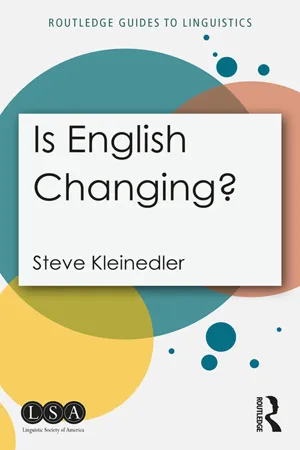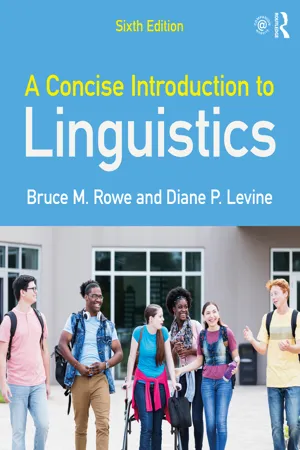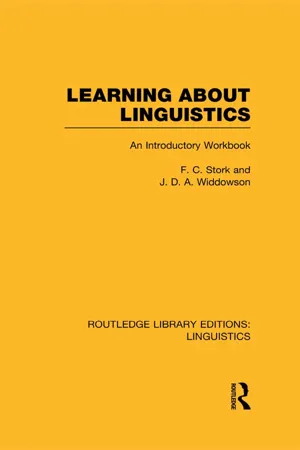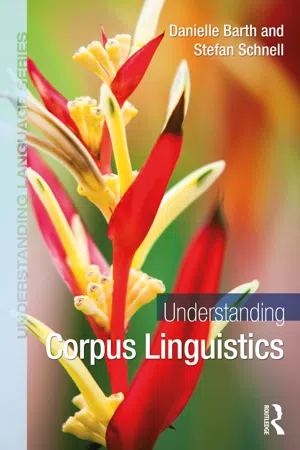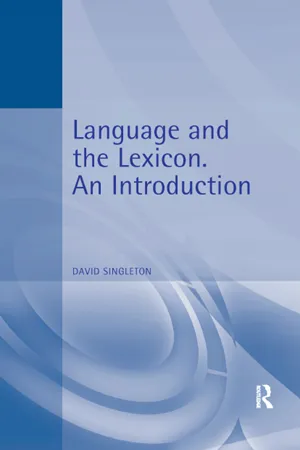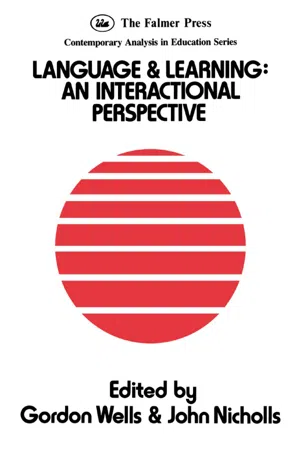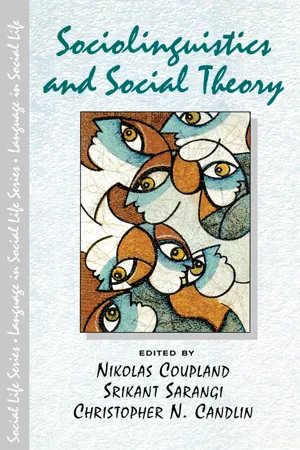Languages & Linguistics
Sociolect
Sociolect refers to the specific language variety or dialect used by a particular social group or community. It encompasses the unique vocabulary, grammar, and pronunciation patterns that are characteristic of a particular social class, age group, ethnicity, or other social factors. Sociolects play a crucial role in shaping individual and group identities and are influenced by social, cultural, and historical factors.
Written by Perlego with AI-assistance
Related key terms
10 Key excerpts on "Sociolect"
- eBook - ePub
- Steve Kleinedler(Author)
- 2018(Publication Date)
- Routledge(Publisher)
Society and culture
Each of the previous chapters was an overview of a linguistic subfield and examined how English has changed in that subfield.7.0 IntroductionThis chapter deals with SOCIOLINGUISTICS , the study of the influence of society and culture on language, including the way society and culture cause language change. Sociolinguists analyze the phonological, morphological, syntactic, semantic, or pragmatic features of one or more social groups (such as ones categorized by gender, economic class, race, ethnicity, or age). Some sociolinguists document how these linguistic features are manifested in the speech of a particular social group, others compare and contrast similarities and differences across multiple groups, still others document linguistic changes that certain groups innovate.Obviously, no social or cultural group is a monolithic entity. The phonological features of the working class in Pittsburgh are different from those of the working class in Manchester, Baltimore, or Adelaide, and these phonological features change over time.REGIONAL VARIATION (also called DIALECTOLOGY ) is the study of how a language varies from region to region. For languages spoken worldwide like English, the analysis can be global or within a country: for example, documenting a variety of English spoken in the bayous of Louisiana, or comparing English spoken in southwestern England to that of Yorkshire.7.1 Language and varietyImagine two people speaking to each other. Could you tell if they’re speaking the same language, different dialects of the same language, or different languages? Let’s examine what this question means. - eBook - ePub
- Bruce M. Rowe, Diane P. Levine(Authors)
- 2022(Publication Date)
- Routledge(Publisher)
CHAPTER 8 Sociolinguistics: language and societyDOI: 10.4324/9781003268369-8LEARNING OBJECTIVES- Explain the concept of a language community.
- Define the term dialect. Relate the term dialect to the term language.
- List the key characteristics of African American English.
- List the key characteristics of Hispanic English.
- Define pidgin and creole languages.
- Explain situational dialects.
- Discuss stereotypes based on dialect and language variation.
- Define code-switching. Explain why people do it.
- Analyze how language reinforces social identity.
- Explain how men and women use language differently.
The minute you hear a person begin to speak, certain information about that person’s position within the social system is revealed to you. Sociolinguistics is the study of how language and social factors, such as ethnicity, social class, age, gender, and educational level, are related. We have already discussed some topics that are important in sociolinguistics, such as the concept of social meaning (see Chapter 7 ). In this chapter, we go into more detail on subjects of importance to sociolinguistics.Sociolinguistics is the study of how language and social factors, such as ethnicity, social class, age, gender, and educational level, are related.Each person has a unique way of speaking that results from physical, social, and cultural factors: a certain tone of voice, often-used words, and characteristic idioms and phrases. This is why comedians can do impersonations of famous people speaking and the audience can guess who the comedian is imitating. This personal, individual way of speaking is known as an idiolect - eBook - ePub
- Hemalatha Nagarajan(Author)
- 2022(Publication Date)
- Routledge India(Publisher)
SociolinguisticsDOI: 10.4324/9781003099024-7What is your good name, please? I am remembering we used to be neighbours.R. Parthasarathi (1998)Module 1: Language and Society and Language Varieties
Language is not spoken in a vacuum. Apart from individuals who convey their thoughts, ideas, and feelings through the medium of language, language also forms an integral aspect of any society or culture, governed by its norms and practices. The branch of linguistics that deals with how language is used in a society or culture and is governed by factors like gender, race, class, caste, etc., is called sociolinguistics.The English anthropologist Sir Edward Burnett Tylor defined culture as something that is “acquired by man as a member of society” and language too forms an integral part of it as much as the food we eat; the types of clothes we wear; or the traditions, festivals, and practices we follow. We all need food to survive, a roof over our head, and clothes to protect us from ravages of weather. However, the type of food we consume, the type of houses we live in, and the kinds of clothes we wear are dictated by our culture. Likewise, there are a number of aspects of language that are universal. However, in this chapter, we explore those aspects of language which are conditioned by culture, region, class, caste, and other aspects of society.Language Varieties
Any important aspect of social structure and function is likely to have a distinctive linguistic counterpart. People belong to different social classes, perform different social roles, and carry on different occupations (David Crystal 1995 : 3)One’s language can be conditioned by certain static factors and by some dynamic factors. The static factors are aspects like region, class, caste, gender, etc., of the speaker, which remain unaltered in all circumstances.1 There are also some dynamic factors that condition our language use. These are factors like the subject matter, the medium of communication (spoken or written, e-mail, or text message), and the addressor–addressee relationship, fashions in language use, etc. The static factors mostly lead to dialects, and the dynamic factors contribute to differences in registers - eBook - ePub
- F.C. Stork, J.D.A. Widdowson(Authors)
- 2014(Publication Date)
- Routledge(Publisher)
dialect is most often used in respect of differences which result from geographical situation, but sociological features are equally important and they play a particularly dominant role in varieties of English. A dialect is a variety of language, which is either regional or social in origin (or a combination of these) which is spoken by certain members of the speech community.In England there are many regional dialects which have an equally long history going back to Old English times and the coming of the Angles, Saxons and Jutes in the fifth century A.D. In fact the modern regional dialects have all evolved from the four regional dialects of Old English. In everyday language the term dialect is often thought of as being concerned with rural uneducated speech. Dialectology, however, as a branch of linguistics is concerned with all regional types of speech in towns and cities as well as in villages and in rural communities. The so-called ‘standard language’ itself is nothing more than a regional dialect which has taken on its prestigious role as a result of various geographical, cultural, political and social pressures. Regional dialects can differ from each other in three principal ways:(1) phonology (2) grammar (3) lexisIn the twentieth century the most important distinctions between regional varieties of speech in English are to be found on the phonological level. Some dialectologists make a useful distinction between ACCENT , which is a variety of language differing from other varieties merely on the level of phonology, and DIALECT which differs from other varieties in grammar and lexis as well as phonology.In the British Isles geographical and social factors overlap in the various dialects. As a general rule speakers of high social or educational status from all parts of the country tend to modify their speech towards the norms of Southern British English. The term standard English is often used to refer to written forms of the language which conform to the patterns and grammatical norms of the socially accepted speech variety based on Southern British English. On the phonological level the pronunciation of educated speakers from that area is also taken as the standard and is often referred to as RECEIVED PRONUNCIATION (RP) . Both standard English and Received Pronunciation refer to those kinds of English which are typical of educated speakers from London and the south east and are free from other regional variations. They are also used as models for teaching English to non-native speakers. What is regarded as ‘standard’ or ‘received’ cannot be defined in absolute terms, not least because it is the nature of language to be in a constant state of change. It is therefore impossible to legislate for what is acceptable or unacceptable for more than a brief period of time. Even in those countries where there is an Academy or other official body for laying down standards of language (e.g. L’ Académie Française in France) the everyday speech of the people is scarcely influenced by its prescriptive pronouncements. English has no such official body and what is regarded as standard is based on a consensus of opinion among its educated speakers. There are therefore varieties of standard English which vary from place to place and from time to time. Educated people from areas outside the south east may speak modified forms of standard English which might be called regional standards. Such regional standards, however, are largely a question of accent: i.e. they differ from each other mainly on the phonological level. The speech of BBC announcers from Bristol may include the West Country [r] sounds and an announcer from Manchester may use the northern [a] and these minor variations alone mark their pronunciation as different from RP - eBook - ePub
- Gerard Van Herk(Author)
- 2012(Publication Date)
- Wiley-Blackwell(Publisher)
Linguists use the principle of mutual intelligibility to distinguish a language from a dialect, but speakers and governments may apply different criteria. Sociolinguists label distinct subsets of a language as dialects or varieties, reserving terms like slang or accent for specific linguistic domains. We study language in use, at the level of the social group. Depending on our research interests and assumptions, we may define the social group as a speech community, social network, or community of practice, each of which implies a greater level of speaker agency in linguistic interactions.Where to next?ExercisesThere are two big (and possibly competing) pulls in how sociolinguists consider language use these days. One approach, which we might label the telescope view, uses quantitative methods (and improving technology) to conduct large-scale studies of large data sets. People using this approach, influenced by the growing discipline of corpus linguistics , work to develop statistical methods, automated data extraction and analysis, and database building methods. This approach is especially well suited to investigating language changes that are widespread or that occur over a long period of time. Another approach, which we could call the microscope view, uses mostly qualitative methods to conduct small-scale, intensive studies of particular communities of practice. People using this approach, influenced by anthropology, work to develop conversation analysis tools and to identify locally significant social distinctions. There’s some hope, though, that the two approaches can work together. For example, the (telescope) Ottawa Intensifier Project found quantitative evidence that nerds, in particular, actively distance themselves linguistically from other youth subcultures, confirming the findings of Bucholtz’s (1999) well-known (microscope) study of nerd girls in high school.1. Ask people if they can think of any inside jokes, things that only make sense (or are funny) to a small group of people who know the “back story.” These might include strange definitions, things that refer back to a particular event, or unusual pronunciations of a word (for some reason, lots of families seem to have at least one of these that results from how somebody in the family pronounced something when they were very young). Write them down; look for common traits among the things people tell you. - eBook - ePub
- Rob Penhallurick(Author)
- 2018(Publication Date)
- Bloomsbury Academic(Publisher)
semantics. Currie uses the term in his article ‘A projection of socio-linguistics: The relationship of speech to social status’ (1952), which deals with the variation of speech according to social register (Koerner, 1991, p. 65). Apparently Currie had used the word at a conference in 1949 (Hymes, 1979, p. 141; Joseph, 2002, p. 109). By the mid 1960s, the term was starting to become the favoured name for a new branch of linguistics. Its scope was wider than that of dialectology, and its aims, thinking, methods, and even terminology differed in significant ways from dialectology.For example, to a sociolinguist the term phonology means something quite different from what it meant to A. J. Ellis. To Ellis, the term referred to the study of sounds in a language or dialect, in particular their history and the accurate description of their articulation. To a sociolinguist the term refers generally to the functions that sounds have and the place that they occupy in the relational sound system of a language or dialect (a rather more abstract viewpoint), whereas the description of their production and acoustic perception belongs to phonetics. Sociolinguistics belongs to modern structuralist linguistics, in which there is an emphasis on investigating the function and place of linguistic features in the context of the (structural) networks or systems which they form, so that the account of, for example, a given sound-feature is concerned with its function considered alongside (the functions of) other sound-features in a dialect or language. To use a simple illustration, the sounds represented by the letters b and p in the English words bit and pit are phonetically very similar, but the small phonetic contrast between them ([b] is voiced, [p] is not) is used phonologically in English to distinguish words and meanings, as evidenced by bit and pit, giving two structural units or phonemes, /b/ and /p/. The Finnish language, alternatively, has no phonological distinction based on the phonetic difference between [b] and [p]. Different languages and different dialects of the same language can make use of the array of possible consonant and vowel sounds to create different phonological or phonemic systems. Conventionally in notation a phoneme is enclosed between forward slashes, for example, /b/ and /p/, and /r/, and so on. Actual phonetic realizations or performances of sounds in utterances are transcribed between square brackets, for example, [r], meaning a ‘rolled’ or ‘trilled’ articulation of /r/, distinguished from an approximant [ɹ ] or retroflex [ɽ ] or flapped [ɾ ] articulation of /r/, and so forth. (For a rolled articulation the tip of the tongue taps the upper teeth-ridge several times quickly; for a flapped articulation it does so once; for an approximant the tip of the tongue is curled back slightly but does not touch the roof of the mouth; for a retroflex articulation it is curled back much more.) Each of these in the English language is a phonetic variant of the /r/ phoneme. Each of these variants is different in sound, but the sound-differences do not distinguish word meaning. They do not perform that phonological function. We use these phonetic transcriptions for the actual sounds of speech, but we use the phonemic symbols for the functional elements of sound systems, that is, the elements whose contrasts affect meaning. (And we use the term phonological variable - eBook - ePub
- Danielle Barth, Stefan Schnell(Authors)
- 2021(Publication Date)
- Routledge(Publisher)
The focus on vowels in sociolinguistics is motivated by their specific characteristics: vowels are continuous and lack hard breaks between one another. Speakers may thus produce a vowel a bit differently each time they pronounce it, and listeners will mostly still understand it as the intended sound. The variation in production from each person can build up to variability within a population (or community). Vowels, then, can change quite quickly over time. If you listen to speech from an elder (or young person) of your community, you might notice some words are pronounced differently than your own. Sounds, especially vowels, can also vary quite drastically across different regions and countries, even within a single language. This makes sounds a hotbed of variability that can be measured (by formant frequency, among other measurements) which makes for interesting studies.- (4) Sociolinguistic fieldwork: Like documentary linguists (Chapter 10 ), many sociolinguists collect their corpus data themselves during fieldwork in speech communities, with whom they tend to become very familiar. This means different kinds of questions are asked for the data and that many explanations for patterns of language use come from understanding the communities, people, and personalities the linguist is working with. Sociolinguists often want to situate language in its social and interpersonal contexts, and so much more information is needed about specific people and their relationships to and within their communities (cf. Kendall 2011 ). This also means that, like documentary corpora more generally, sociolinguistic corpora are much smaller than corpora of better-studied standard languages.
9.1.2 Variables in sociolinguistics
In sociolinguistics, a variety of language can be an accent, style, dialect, language, or a specific kind of language used for study. From decades of sociolinguistic research, we know that groups of people use a constellation of linguistic features (what sociolinguists call the variants of linguistic variables). Some people will use one variant of a linguistic variable more often, others will use another. Some of these differences are at the level of consciousness and others are below. Some variants are also strongly associated with some groups as identifying features. In sociolinguistics, variants are discussed as ‘stereotypes’, ‘markers’, or ‘indicators’ following a tradition set out by William Labov (1972) , one of the most well-known sociolinguists in the field. Stereotypes are linguistic features that many people will consciously associate with a group of language users, although they may not be accurate. For instance, people may associate African American Language (sometimes called African American English, African American Vernacular English or Black English) with copula deletion: He my brother. Or people may associate young women’s speech with a creaky voice. Or people may associate Australian English with a lot of lexical shortenings like arvo (afternoon), barbie (barbeque), poli (politician), rego (registration), and tradie (tradesman). Markers and indicators are features that language users of a variety (and non-users of that variety) are not aware of but help distinguish a particular variety. Markers are variables that language users have a subconscious awareness of, which is demonstrated through the increased or decreased usage of that variable in more informal versus formal varieties of speech. For instance, a young professor may use a variant less while lecturing and more while she is at a bar with friends without actively choosing to do so. An indicator - eBook - ePub
Language and the Lexicon
An Introduction
- David Singleton(Author)
- 2016(Publication Date)
- Routledge(Publisher)
The area of sociolinguistics – more than any other area of linguistics in my view – is extremely well served as far as the range of well-written accessible introductions is concerned. The following four titles all fall into this category, and all deal, to a greater or lesser extent, with lexical dimensions of language variation:J. Holmes, Sociolinguistics: an introduction to language and society (Harlow: Longman, 1992);R.A. Hudson, Sociolinguistics (second edition, Cambridge: Cambridge University Press, 1996);P. Trudgill, Sociolinguistics: an introduction (second edition, London: Penguin, 1995);R. Wardhaugh, An introduction to sociolinguistics (third edition, Oxford: Blackwell, 1997).Very readable but rather shorter introductions to this topic are to be found in Chapter 8 of V. Cook’s Inside language (London: Arnold, 1997) and Chapter 10 of V. Fromkin and R. Rodman’s An introduction to language (sixth edition, New York: Holt, Rinehart & Winston, 1996).Readers looking wishing to explore further may wish to consult:F. Coulmas (ed.), The handbook of sociolinguistics (Oxford: Blackwell, 1997);N. Coupland and A. Jaworski (eds), Sociolinguistics: a reader and coursebook (London: Macmillan, 1997);R. W. Fasold, Sociolinguistics of society (Oxford: Blackwell, 1984);R. W. Fasold, Sociolinguistics of language (Oxford: Blackwell, 1990).With regard to particular aspects of language variation, the following titles are recommended. Geographical variation:J. Cheshire (ed.), English around the world (Cambridge: Cambridge University Press, 1991);P. Trudgill, Dialects (London: Routledge, 1994).Social variation:L. Milroy, Language and social networks (second edition, Oxford: Blackwell, 1987);P. Trudgill, The social differentiation of English in Norwich (Cambridge: Cambridge University Press, 1974).Ethnic variation:V. Edwards, Language in a black community (Clevedon: Multilingual Matters, 1986);W. Labov, Language in the inner city: studies in the Black English vernacular (Philadelphia: University of Pennsylvania Press).Gender-related variation:J. Coates, Men, women and language: a sociolinguistic account of gender differences in language - eBook - ePub
Language And Learning
An Interactional Perspective
- John Nicholls, Gordon Wells, Gordon Wells(Authors)
- 2004(Publication Date)
- Routledge(Publisher)
sociolinguistic is a theoretical distortion aimed at maintaining a distinction between that which is held to be autonomously and therefore properly linguistic, and that marginal area where language and society interact. I believe that this is a false dichotomy which cannot and should not be maintained.Obviously, in making the above claim, I am dealing in generalizations. There have always been socially oriented views of language and some of them have been highly important—even during the last two or three decades. That is certainly true of the work of Malinowski, Firth and Pike, as well as that of Bernstein and Halliday more recently. I am simply attempting to characterize those views which have held dominance, not to indicate the whole range of work in the field. This change of perspective is so far reaching and radical in its effects and implications as to constitute a fundamental re-ordering of the field of language study; it also necessitaties a total rethinking in areas such as the interrelation of linguistic theorizing and educational practice.The earlier view, with its focus on specific linguistic structures within an autonomously conceived language system led, in educational practice to attempts to measure such things as linguistic abilities, development, deficiencies, maturity, etc., in terms of the command of and facility with specific syntactic forms. Evidence was sought in clause-structures, sentence forms, tenses, embeddings, and in ability to operate certain syntactic transformations (Chomsky, 1969; Menyuk, 1969; Hunt, 1970). The literature in this area is vast—I cite these three influential examples merely to indicate the kind of work I have in mind. - eBook - ePub
- Nikolas Coupland, Srikant Sarangi, Christopher N. Candlin(Authors)
- 2014(Publication Date)
- Routledge(Publisher)
Chapter 12 ). Against this three-part structure, we can then assess in more detail where sociolinguistics ‘fits in’ with the main currents of social theory, and how it might become more substantively engaged in social theory.It becomes clear that the approach that came to dominate sociolinguistics in its early decades — the study of variation and change in language and dialect — is closely associated with one early-established, general type of social theory. It builds on the assumption that we confront social life as a structured set of social categories which, to some extent, control our social characteristics and opportunities. On the other hand, some important other strands of sociolinguistics, most of those using the terms ‘discourse’ or ‘interaction’ in identifying themselves, align rather more with a second type of social theory. This type assumes that social life and our entire experience of society is best seen as structured through local actions and practices (see Eckert 2000). This ‘bottom-up’ perspective is radically different from the first. In its more extreme forms we find approaches which reject the claim that social structures outside of local interactions have any reality. Sociolinguistics currently seems content to endorse both perspectives, with varying degrees of antagonism between them.In the later part of the chapter I consider a third general type of social theory. We can call it an ‘integrationist’ perspective, where social theory actively tries to reconcile the distinctions between the first and second typesand, especially, works to bridge the ‘micro-macro divide’. A good deal of contemporary social theory can, in the very general terms being used here, be accommodated within this third type, although there are also very substantial differences between the agenda and emphases of different theorists and many gaps in current accounts. My main ambition for the chapter is to assess what integrationist social theorising, in all of its internal diversity implies for sociolinguistics, and vice versa. I shall argue, in fact, that sociolinguistics can take on a major role in integrationist social theory, bridging between macro-social concerns and the analysis of local communicative practice, and between theory and application.
Index pages curate the most relevant extracts from our library of academic textbooks. They’ve been created using an in-house natural language model (NLM), each adding context and meaning to key research topics.
